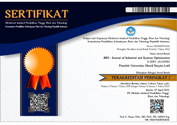EVALUASI PENERAPAN LEAN MANUFACTURING, BEBAN KERJA FISIK DAN MENTAL PADA DIVISI MANUAL SETTING
DOI:
https://doi.org/10.51804/jiso.v7i1.39-45Keywords:
waste, workload, time and motion study, WISN, NASA-TLXAbstract
PT. XYZ is a company that runs in the field of producing various types of notebooks and chemicals. The selection of samples in the manual setting process is selected based on the manual setting process, which is a labor-intensive area that is still manual and requires many workers in the process. In the manual process of setting humans (workers) have an important role in producing a more efficient work system because in the manual process setting is still done manually. In this case, a lean approach in the form of total waste observation that analyzes all workers in the manual setting process needs to be done as an effort to produce a better work system. The lean approach used in this project uses the time and motion study method. In addition, eliminating waste can contribute to environmental sustainability by reducing negative impacts on the environment, such as excessive use of resources. The purpose of calculating physical workload and mental workload is to understand and manage optimal employee working conditions. With a better understanding of physical workload and mental workload, companies can implement strategies and policies that support employee work-life balance, support psychology and increase satisfaction and productivity. Time and motion study method to reduce waste that occurs. Workload Indicator of Staffing Needs (WISN) Method In this study, the WISN method was used to analyze operator workload in Manual Settings. The stages of workload analysis using the WISN method can be explained as follows: NASA-TLX Questionnaire Method NASA-TLX questionnaire method. Based on the results of the trial, it shows that the results of the first and second trials have exceeded the baseline output. While the calculation using the WISN method, the result of staff workload was 2.1. This ratio shows that the workload of WISN results > 1, then, in the manual setting division has an underload workload which means that the workload or labor owned exceeds the given workload. For the NASA-TLX questionnaire method, the highest mental workload was obtained by operator 1 (team leader), while the lowest mental workload was obtained by Operator 5 with an average workload of 64.278%.
PT.XYZ merupakan Perusahaan yang berjalan dalam bidang memproduksi berbagai jenis buku tulis dan bahan kimia. Pemilihan sampel pada proses manual setting dipilih berdasarkan pada proses manual setting merupakan area padat karya yang masih manual dan membutuhkan banyak pekerja dalam proses tersebut. Di dalam proses manual setting manusia (pekerja) memiliki peran penting dalam menghasilkan sebuah sistem kerja yang lebih efisien karena pada proses manual setting masih dikerjakan secara manual. Dalam hal ini, pendekatan lean berupa total waste observation yang menganalisis semua pekerja dalam proses manual setting perlu dilakukan sebagai upaya menghasilkan sistem kerja yang lebih baik lagi. Pendekatan lean yang digunakan pada project ini menggunakan metode time and motion study. Selain itu, mengeliminasi pemborosan dapat berkontribusi terhadap kelestarian lingkungan dengan mengurangi dampak negatif terhadap lingkungan, seperti penggunaan sumber daya yang berlebihan.Tujuan penghitungan beban kerja fisik dan beban kerja mental adalah untuk memahami dan mengelola kondisi kerja karyawan yang optimal. Dengan pemahaman yang lebih baik mengenai beban kerja fisik dan beban kerja mental, perusahaan dapat menerapkan strategi dan kebijakan yang mendukung keseimbangan kehidupan kerja karyawan, mendukung psikologi serta peningkatan kepuasan dan produktivitas. metode time and motion study untuk menguragi pemborosan yang terjadi. Metode Workload Indicator of Staffing Needs (WISN) Pada penelitian ini, metode WISN digunakan untuk menganalisis beban kerja operator di Manual Setting. Tahapan analisis beban kerja menggunakan metode WISN dapat dijelaskan sebagai berikut Metode Kuisioner NASA-TLX Metode kuisioner NASA-TLX. Berdasarkan hasil trial menunjukkan bahwa hasil trial pertama dan kedua sudah melebihi output baseline. Sedangkan perhitungan menggunakan metode WISN, diperoleh hasil beban kerja staf sebesar 2,1. Rasio ini menunjukkan bahwa beban kerja hasil WISN > 1 maka, pada divisi manual setting memiliki beban kerja underload yang berarti beban kerja atau tenaga kerja yang dimiliki melebihi beban kerja yang diberikan. Untuk metode kuisioner NASA-TLX diperoleh hasil beban kerja mental paling tinggi diperoleh oleh operator 1 (ketua regu), sedangkan beban kerja mental terendah didapatkan oleh Operator 5 dengan rata-rata beban kerja sebesar 64,278%.
References
Ayunda, P. M. (2021). Lean Manufacturing untuk Meminimasi Lead Time dan Waste agar Tercapainya Target Produksi (Studi kasus: PT. Rollflex Manufacturing Indonesia). Jurnal Teknik Industri, Vol. 11, No. 1.
Barnes, R. (1980). Motion and Time Study Design and Measurement of Work. Quinn – Woodbine, Inc.
Ciptani, M. K. (2001). Peningkatan Produktivitas dan Efisiensi Biaya Melalui Integrasi Time & Motion Study dan Activity-Based Costing. Jurnal Ekonomi Akutansi, Fakultas Ekonomi-Universitas Kristen Petra.
David, J. K. (2016). Toyota Way Fieldbook?: A Practical Guide for Implementing Toyota’s 4Ps.
Eni Mahawati., F. R. (2021). Analisis Beban Kerja dan Produktivitas Kerja. Yayasan Kita Menulis, 2021.
Santoso, A. & Fudhla, A. (2018). Perbaikan Sistem Produksi Kardus Dengan Pendekatan Lean DMAI Di PT Kedawung CCB. JISO : Journal of Industrial and Systems Optimization. Col 1 issue 1 page 39-46
Gasperz, V. (2007). Lean Six Sigma for Manufacturing and Service Industries. PT. Gramedia Pustaka Utama.
Khunaifi, A. P. (2022). Implementasi Lean Manufacturing untuk Meminimasi Pemborosan (Waste) Menggunakan Metode Value Stream Mapping di PT. Pura Barutama. Jurnal Rekayasa Industri (JRI), Vol. 4 No. 2, Oktober 2022.
Kila, Y. A. (2022). Pengaruh Time and Motion Study Terhadap Kinerja Security Pada Kantor Perwakilan Bank Indonesia Provinsi Sulawesi Selatan. Makassar: Universitas Bosawa.
M, L. P. (2021). Penerapan Lean Manufacturing Guna Minimasi Waste Pada Lantai produksi. ARIKA. Vol. 14, No. 1. ISSN: 1978-1105.
Maulana, A. H. (2016). Usulan Lean Manufacturing System untuk Mereduksi Waste Dan Efisiensi Biaya Produksi Di PT. ABC Divisi Slab Steel Plant 1.
Noval, P. d. (2013). Kajian Sistem Prosedur Bongkar Muat Barang Pada Angkutan Kereta API. Volume 25, Nomor 1, Januari 2013.
Nuha, W. W. (2018). Pengukuran Beban Kerja Mental Karyawan dengan Kuisioner NASA TLX (Studi Kasus:Universitas ABC). Simposium Nasional RAPI XV11 – 2018 FT UMS ISSN 1412-9612.
Nuha, W. W. (2019). Workload Analysis Using Work Sampling and NASA-TLX for Employee of Private University in Surabaya. Jurnal Ilmiah Teknik Industri, p-ISSN 1412-6869, e-ISSN 2460-4038.
Prasandi, F. P. (2023). ). Analisis Beban Kerja Mental dan Fisik Menggunakan Metode National Aeronautics and Space Administration Task Load (NASA-TLX) dan Cardiovascular (CVL) (Studi kasus: CV. Griya Serasi Produk Utama). Semarang.
Rother, M. &. (2001). Creating Continous Flow. Bookline, Massachusetts, USA.: THE LEAN ENTERPRISE INSTITUTE.
Tirtayasa, E. N. (2021). Studi Literatur: Pengukuran Beban Kerja. Jurnal Penelitian dan Aplikasi Sistem & Teknik Industri (PASTI), Vol. XV, No. 2, Agustus 2021, 194-205.
Downloads
Published
Issue
Section
License
Copyright (c) 2024 JISO : Journal of Industrial and Systems Optimization

This work is licensed under a Creative Commons Attribution-ShareAlike 4.0 International License.
With the receipt of the article by JISO Editorial Board and the decision to be published, the copyright regarding the article will be transferred to JISO. The copyright transfer form can be downloaded here.
JISO has the right to multiply and distribute the article and every author is not allowed to publish the same article that was published in this journal.
JISO is licensed under a Creative Commons Attribution-ShareAlike 4.0 International License.
Under the following terms:
Attribution — You must give appropriate credit, provide a link to the license, and indicate if changes were made. You may do so in any reasonable manner, but not in any way that suggests the licensor endorses you or your use.
ShareAlike — If you remix, transform, or build upon the material, you must distribute your contributions under the same license as the original.














